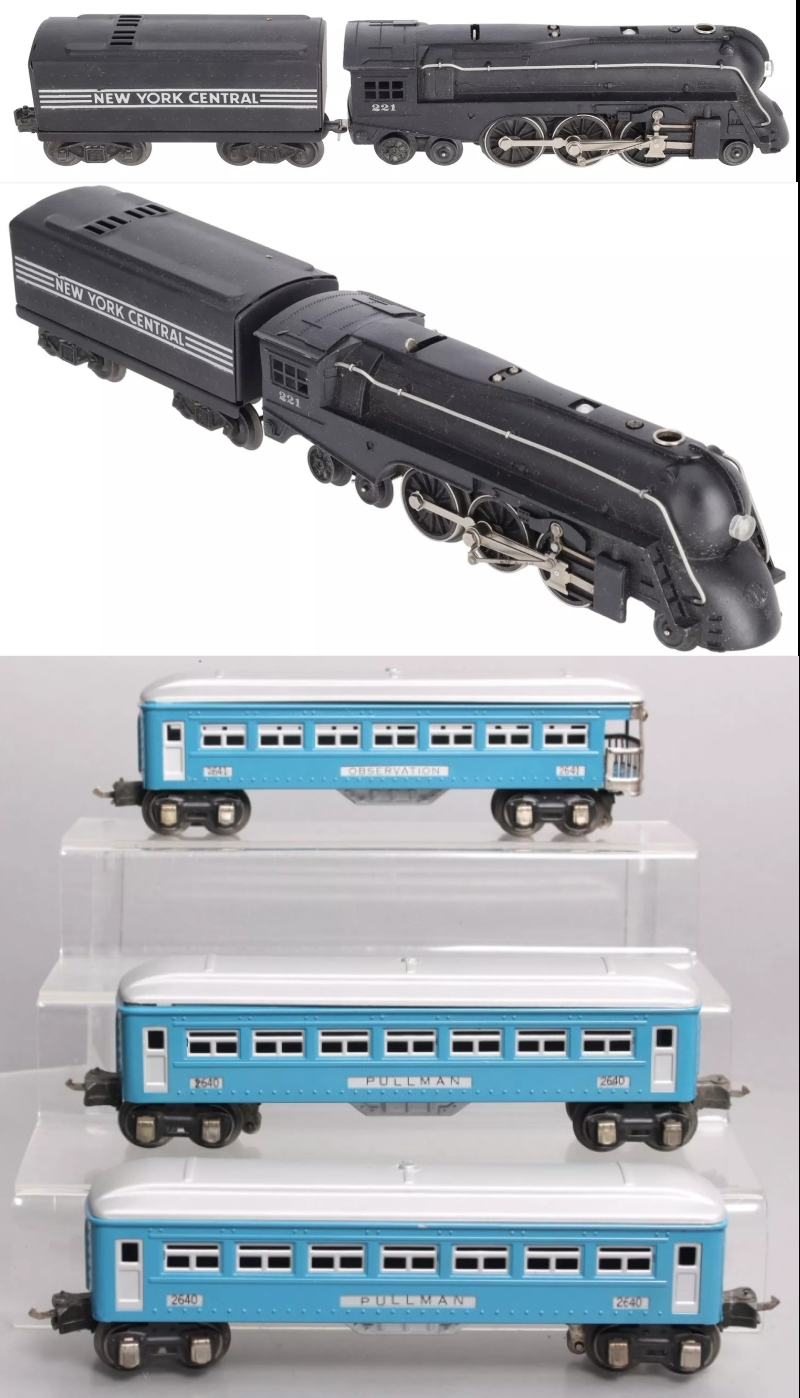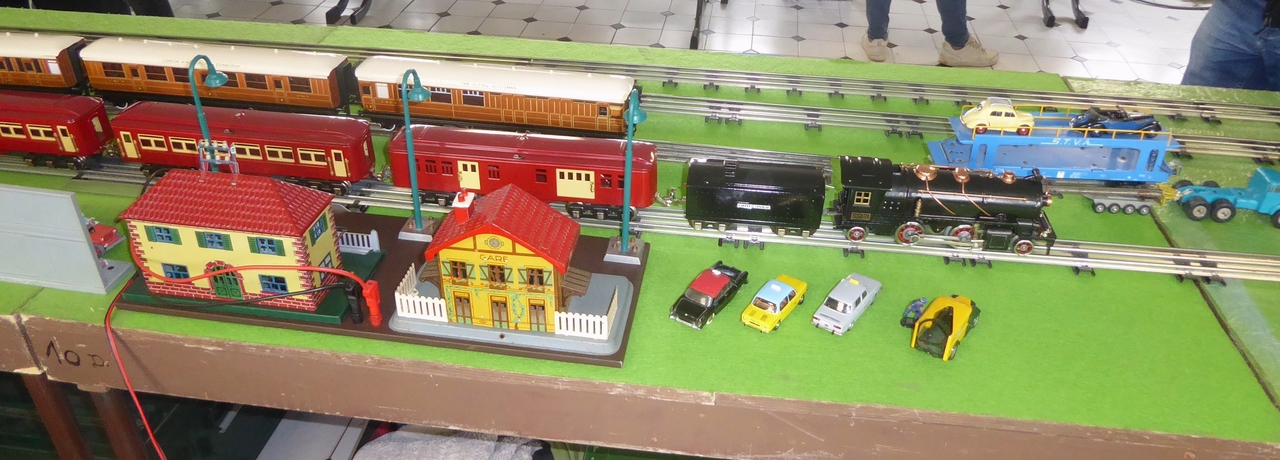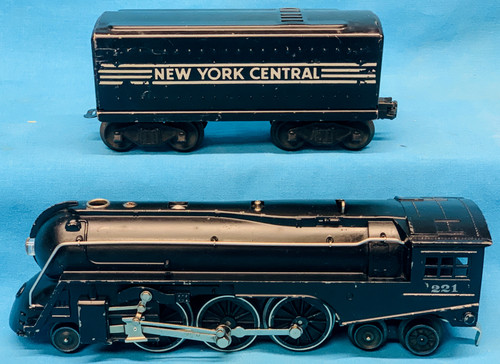oace
Full Member
  
Posts: 241
|
Post by oace on Oct 25, 2024 20:48:12 GMT
My little US section is going to be completed : I wait for a small set of NYC Lionel train, consisting of a #221 and 3x #2640-1 cars...  To be delivered in mid / end of November.  I will indeed have historical / technical questions about it, you guess it !  Wait and see... OACE
|
|
|
|
Post by af3020 on Oct 26, 2024 16:01:17 GMT
Well, lesseee - you have a postwar engine with knuckle couplers and three pre-war passenger cars with automatic hook couplers. Lionel made an adapter to allow the two to couple - the part number back then was TT-100 or TS-162. It looks like Henning's Trains stocks an MTH reproduction of the TT-100 so you should be able to couple the cars and the engine without a problem. hennings-trains.shoplightspeed.com/parts/prewar-couplers/and if they are out then you can Try TrainZ www.trainz.com/products/lionel-ts-100-coupler-adapter-1... of course, if the cars are destined to be pulled by your 262E then there is no problem. |
|
oace
Full Member
  
Posts: 241
|
Post by oace on Oct 26, 2024 16:31:05 GMT
Well, lesseee - you have a postwar engine with knuckle couplers and three pre-war passenger cars with automatic hook couplers. Lionel made an adapter to allow the two to couple - the part number back then was TT-100 or TS-162. It looks like Henning's Trains stocks an MTH reproduction of the TT-100 so you should be able to couple the cars and the engine without a problem. hennings-trains.shoplightspeed.com/parts/prewar-couplers/and if they are out then you can Try TrainZ www.trainz.com/products/lionel-ts-100-coupler-adapter-1... of course, if the cars are destined to be pulled by your 262E then there is no problem. Thanks again af3020 for your tips in advance ! I'll note all this and see what it looks like when the set will be here... That said : 1 - I saw two type of wheels for the Lionel 221 Dreyfuss : some are like the ones on my pictured 221, others have no rolling rims and rather look plain, like the ones found on models like 2046 and the like. This is somewhat like the difference between Berkshire 726 and 736 wheels, that led me to think that my engine could similarly be a prewar model, with a modernized coupler added by a previous owner ? 2 - To be in such fine condition, the passenger cars have certainly been restored / refinished (nicely). Again, if these are prewar, then I guess that the couplers have been changed, as they do not look like the ones of my 262E +1689W or IVES by Williams #1694 ? 3 - Would those 2640 and 2641 cars be too small compared to my 262E ? And compared to my 1665/6/7 passenger cars below ?  OACE
|
|
|
|
Post by af3020 on Oct 26, 2024 20:54:59 GMT
Ok, let's do some train spotting 1. The 221 was offered pre and post war period with the fancier rims around the engine drivers. The one you have appears to be the post war version with i s supposed to have the knuckle couplers - here's a picture of one of these in Set #1433 from 1947.  2. The cars look to be nicely repainted. They came in a darker blue with aluminum trim or a dark green with cream trim. As for the couplers - they are correct for the cars - Lionel made changes to their couplers all through the 1930's. The couplers on your #262 are the earlier versions. By the time Lionel offered the cars you have they had changed to the type seen in the picture. 3. Those cars should be fine running behind either your 262E or the #221. |
|
oace
Full Member
  
Posts: 241
|
Post by oace on Oct 26, 2024 22:22:04 GMT
I see... Thanks again af3020 for instructing me : you really are a Tinplate O gauge Train Model Encyclopedia !    OACE |
|
|
|
Post by healey36 on Oct 27, 2024 1:36:50 GMT
Wait, a version of the 221 was manufactured and sold before WWII? I’ve not heard that before...I always thought it was produced immediately after the war (1946 or 1947). I’ve seen folks mate the 221 with a prewar coffin-style tender (1689/2689 types), very similar to the postwar 221T/221W versions.
I have one that The Old Man left behind...needs a bit of work. Someone repainted it at some point, including the nickel-rimmed drivers. It’s in the project pile...get to it eventually.
|
|
|
|
Post by af3020 on Oct 27, 2024 2:12:48 GMT
You're right Healey36 - let's wait - I knew I should have dragged out my Lionel reference book before typing that - I was thinking of the #238 - 221 is strictly a postwar train - my bad.  |
|
|
|
Post by healey36 on Oct 27, 2024 2:27:18 GMT
You're right Healey36 - let's wait - I knew I should have dragged out my Lionel reference book before typing that - I was thinking of the #238 - 221 is strictly a postwar train - my bad.  af, I seem to remember reading somewhere that Lionel penned the 221 design before the war, just didn’t get it into production until after. I’ll look around and see if I can find a reference. Maybe that’s why they used the coffin-style tender with it, dunno. Definitely has a prewar look about it.
|
|
oace
Full Member
  
Posts: 241
|
Post by oace on Oct 27, 2024 7:44:58 GMT
I see... Here's what I quickly found about the Lionel 221 : postwarlionel.com/221-dreyfuss/It is stated that this locomotive was produced in 1946 and 1947, so yes : no prewar models à priori... But was the 221 originally glossy painted ? Like below :  I must confess that gloss enhances her "Torpedo" profile nicely !  The one that I had 30 years ago was "satin finish"... Like all those I saw on the web, no matter Black or Grey. OACE |
|
|
|
Post by healey36 on Oct 27, 2024 8:56:54 GMT
I think the first year was a satin finish gunmetal, then a satin black thereafter. Most I see are gunmetal, which looks sharp. The one we have here is black, but it’s been poorly repainted. I’ve never taken it apart to see if black was the original color. The gloss paint on the one in your picture looks terrific, but not original. It seems like there are quite a few of these around for having been made for just two years. Here's the one we have here. The locomotive was repainted by a previous owner; the tender was repainted by me, with new decals (stickers) applied. It looks better in this pic than it does in person, lol:   |
|
|
|
Post by af3020 on Oct 27, 2024 13:52:31 GMT
From the Greenberg reference we have the following:
Production 1946-1947
1946 - gray body aluminum-finished drivers without tires
1946 - same as above but black finished drivers
1947 - black body, black drivers with nickel tires.
Not year specific
Black body, aluminum-finished drivers without tires
Black body, black drivers without tires
Gray body, black drivers with nickel tires
Greenberg also states that planning for this engine was started in 1942 (Lionel internal memos) and was planned for offering in the immediate post-war period.
There's no mention of gloss vs satin black and while I've seen a number of these engines for sale over the years I can't recall seeing one in a gloss black finish - but that is just one person and one set of samples.
|
|
oace
Full Member
  
Posts: 241
|
Post by oace on Oct 27, 2024 14:49:55 GMT
Thank you healey36 and af3020 !    "with new decals (stickers) applied" : what you call a sticker is auto-adhesive ( autocollant in French), per opposition to waterslide ( décalcomanie in French) - am I right ? "1947 - black body, black drivers with nickel tires." : yes, I think that's in accordance with what I bought. What you call "drivers" are the hub and spokes (flanges ?) of a wheel ( moyeu, rayons, voile d'une roue in French), and what you call the "nickel tires" are the surrounds, the rims ( jantes in French) - am I right again ? So if I am correct, this 221 below would be considered as a "1946 - gray body aluminum-finished drivers without tires" : www.ebay.fr/itm/296731833022?_skw=lionel+221&itmmeta=01JB775VPJM1J92G6MJKW66HSM&hash=item45169872be:g:tP8AAOSwZstnAHErMy apologies for my dubious understanding !   OACE |
|
|
|
Post by af3020 on Oct 27, 2024 17:31:25 GMT
Oace, what Greenberg is calling the "tires" is the nickel trim piece around the circumference of the drive wheels. I'm pretty sure when they say "driver" they mean the center part of the drive wheel. Thus the engine you have shown in your listing would be a gray engine with black drivers. The one thing that bothers me about what I just said is this would mean there are #221's out there with the center of the drive wheel painted with an aluminum finish and I know I've never seen one like that....so if we do some Google searching we will find the following: train-station.com/Pages/archives/Library/PW-221SILVERGRAY.html Given the number of 221's I've seen over the years I would have to agree with the above site - it is indeed a rare color for those drive centers. |
|
oace
Full Member
  
Posts: 241
|
Post by oace on Oct 27, 2024 18:37:27 GMT
Oace, what Greenberg is calling the "tires" is the nickel trim piece around the circumference of the drive wheels. I'm pretty sure when they say "driver" they mean the center part of the drive wheel. Thus the engine you have shown in your listing would be a gray engine with black drivers. The one thing that bothers me about what I just said is this would mean there are #221's out there with the center of the drive wheel painted with an aluminum finish and I know I've never seen one like that....so if we do some Google searching we will find the following: train-station.com/Pages/archives/Library/PW-221SILVERGRAY.html Given the number of 221's I've seen over the years I would have to agree with the above site - it is indeed a rare color for those drive centers. OK, I see... Thanks af3020 !    OACE
|
|
|
|
Post by healey36 on Oct 28, 2024 1:40:22 GMT
"with new decals (stickers) applied" : what you call a sticker is auto-adhesive ( autocollant in French), per opposition to waterslide ( décalcomanie in French) - am I right It was a long time ago, but yes, a self-adhesive “decal”, as opposed to one you soak in water and slide onto the model. I don’t like self-adhesive stickers for two reasons: (1) unlike a water-slide decal, a self-adhesive sticker doesn’t conform to surface detail like what can be achieved with a water-slide, the medium usually being thicker, and (2) I have found that the adhesive on a sticker eventually fails and the decal peels off the surface. I think both self-adhesive and water-slide types are available today.
|
|